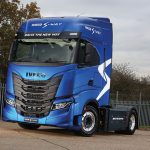
IT HAS BEEN two years since Mercedes-Benz Trucks introduced the Actros 5. Littered with innovations promoting safety and fuel economy, but it was MirrorCam that stole all the headlines (TN, April 2020).
Recognised as a first within the truck sector, MirrorCam is standard. It replaces the Class 2/3 main exterior mirrors as well as the Class 4 wide angle mirror. Both the Class 5 close proximity mirror and Class 6 front mirror remain legal requirements.
Beyond having no mirrors, the new technology is geared towards making Mercedes-Benz Actros the nearest in the commercial vehicle market to being fully autonomous. According to SAE (Society of Automotive Engineers) International, there are six levels of automated driving from ‘no automation’ to ‘full automation’.
Legally, vehicle manufacturers can go to level two, known as ‘Partial Automation’. It is defined as ‘the driving mode-specific execution by one or more driver assistance systems of both steering and acceleration/deceleration using information about the driving environment and with the expectation that the human driver performs all remaining aspects of the dynamic driving task’.
With steering and acceleration/deceleration controlled by the truck, the driver is responsible for ‘monitoring the driving environment’, ‘the fallback performance of dynamic driving task’ and some of the ‘driving modes’.
Combining the new Active Drive Assist (ADA) with Proximity Control Assist with the stop-and-go function, as well as on the Lane Keeping Assist for steering, it works with GPS mapping to read the road ahead and uses the Predictive Powertrain Control1 (PPC) for acceleration/deceleration and reading the road ahead.
Partial Automation can be achieved with the Actros 5 tractor unit, providing it’s a 4×2 or a 6×2 with a tag axle. According to a Daimler spokesperson, fitting it to the 6×2 mid-lift tractor units that dominate the UK sector ‘is not planned’ at the moment.
However, with PPC the truck can achieve level one on the SAE International chart, which is called ‘Driver Assistance’.
Like systems used by its competitors, PPC can help improve fuel consumption by using GPS to map the road ahead for ascents and descents and make appropriate gear changes to retain momentum; unlike its competitors, PPC will adjust the cruise-control speed setting in line with national speed limits, and use the GPS with Traffic Sign Assist to take in junctions and roundabouts and act accordingly.
Covering more than 217,000 miles or 95% of European trunk roads, in the UK there are more than 7,600 ‘truck’ miles, according to the latest report published by the Department for Transport at the start of the year.
As for specification of the truck; this one is on the Western Commercials demo fleet, so might be available for you to try for yourself. Officially it is the Actros Long Distance LS2551 6×2/2 with the Gigaspace cab.
A 12.8 litre Euro 6 Step D six cylinder diesel engine delivers 503hp, badged as a 510. The 2,500Nm torque runs over a shallow apex that starts at 930rpm, peaks at 1,100rpm and starts to fall away sharply at 1,460rpm. It is the second most powerful of the five engines available at 12.8 litres; the others being badged as 421, 449, 476 and 530hp, respectively.
Transmission is the G281-12 Powershift 3, 12-speed and the rear axle is 2.93:1. It is worth pointing out that this is a demo truck, so it is specified to be all things to all operators. With that, it’s worth noting it has an 8,000kg front axle for those who might want something more robust.
Western Commercials selected Gigaspace, which is one of 17 cab variants in two widths, with five roof shapes. Others are CompactSpace, ClassicSpace, StreamSpace and BigSpace. There are also three engine tunnel variants: 320mm, 170mm and level floor, the latter is found in the Gigaspace.
Without the driver, but with brimmed fuel and AdBlue tanks, it weighs 8,637kg. Attached to the truck was a Montracon triaxle curtainsided trailer loaded to 44 tonnes GVW.
The appraisal route took us out of Abington motorway services on the M74 at junction 13 and north to Glasgow where we would join the M73. This section was done at 56mph with revs sat at 1,400rpm. It’s a tad high for true trunking fuel economy, but that’s down to the universal rear axle ratio designed for the more mountainous parts of the country.
Using PPC the truck ebbed and flowed with the traffic. With decent power and torque available, the truck pretty much maintained the pre-set road speed throughout.
Economy mode was activated as the truck joined the M73 towards Denny, which dropped the cruise control setting to its maximum of 53mph and 1,300rpm. Still using PPC, the vehicle slowed to join the M80 and then the M9 before it began to decelerate on the approach to the A9 roundabout at Dunblane.
On the dashboard up came a roundabout and the speed the truck would approach, in this case 19mph. With the roundabout clear, it left the roundabout for the A9 towards Auchterarder and Perth at 25mph. Here PPC recognised this section is 50mph for trucks and adjusted the maximum road speed setting. All the driver did was steer and assess the information provided.
From the M74 to the first timed hill climb, neither the accelerator nor the brake pedal was touched. Putting the truck back into the standard setting for the first timed hill climb of the day on the A9 briefly diverted attention away from the PPC and the pedals.
The Cairnie Braes climb covers 2.5 miles to the summit. Completed in 3 minutes 16 seconds it hasn’t troubled the leader board; that honour remains with the Volvo FH750 which was 11 seconds quicker.
On the approach to the Perth roundabout PPC kicked in again; it used the engine brake to reduce road speed from 50mph to 19mph, once again there was no traffic on the island, and departed on the M90 towards junction 10 to take the southbound at 25mph.
And it was here that our first ‘challenge’ occurred. The truck didn’t pick up that it was in the right hand lane for the southbound M90. The truck appeared to think we’d bare left towards Dundee. It did eventually twig, and quickly dropped road speed to 33mph (official maximum speed is 40mph on the signs).
On the second timed ascent from the Bridge of Earn to the summit of Balmanno Hill the 2551 clocked 4 minutes 15 seconds, a full 22 seconds off the pace of the …yes, you guessed it… Volvo FH750. However, the time was good enough to claim second place on the leader board, as it was one second quicker than the DAF XF480 (TN, October 2019) and the Actros1 2563L (TN, August 2018).
Now the real test began on the final section of the route from the Swanston A702 junction off the Edinburgh bypass down to Abington motorway services; a tad over 35 miles. Once on the A702 at Hillend, PPC took over.
Set at 40mph it navigated the winding road often dropping to 30mph for some of the corners, it was not until we approached the new roundabout (finished last year) connecting the A702 to Mauricewood Road that we realised the trucks software hadn’t identified the roundabout, which meant the driver had to take control.
Conversely, with the roundabout on the descent into West Linton, PPC picked it up early. The truck decelerated from 40mph on the approach to tackle the offset island at 12mph. It was impressive to say the least.
In Biggar the driver took full control of the truck and again in Coulter for the two tight corners left and then right over the bridge that spans the Culter Water.
Where PPC really delivers added value is on a road like the A702. The driver, Western Commercials sales executive Calum Aitken, had not driven down this route before. Allowing PPC to control acceleration and deceleration and read the road ahead meant he steered and only intervened when things beyond PPCs remit occurred, like oncoming traffic, red lights, vulnerable road users and newly installed roundabouts!
The route was travelled quicker because he wasn’t constantly checking the vehicle progress in unfamiliar situations. It also made good use of Ecoroll, which will have saved on fuel use.
All of that would not have been possible by merely using cruise control through that section. The only caveat to all that is it takes on corners which are slight but can be obscured by a hedgerow, tree or a building, which is effectively blind cornering.
Access to the flat floor cabin is via four steps. Inside, the bunk is pinned to the back wall to allow access to the storage facilities but also maximise the space for the seats. On the dash are two, 10 inch interlinked screens, replacing the conventional dashboard. The central area of the display can be configured to suit individual requirements. Gigaspace is spacious, modern and flexible.
In terms of technology there is a clear light between Mercedes-Benz and the rest of the field. It is, along with Tesla Autopilot and Cadillac (General Motors) Super Cruise, the only vehicles that qualify to level two Partial Automation.
As it stands, hauliers can make good use of level one. PPC removed the stop and go nature a driver has from taking a new, unfamiliar route, and it will deliver a consistent performance even if the driver is experienced with the route.
Trust is critical here. Trust that the truck can deliver consistency! The driver does have the final say to override the system if the situation warrants it, but otherwise you should sit back and enjoy the ride.




